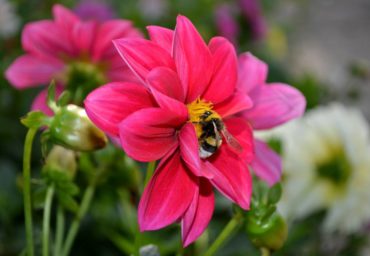 Editor’s note: This excerpt is reprinted with permission from “The Pollinator Victory Garden: Win the War on Pollinator Decline with Ecological Gardening” by Kim Eierman, EcoBeneficial, published Quarto Publishing Group USA Inc. 2020.
Editor’s note: This excerpt is reprinted with permission from “The Pollinator Victory Garden: Win the War on Pollinator Decline with Ecological Gardening” by Kim Eierman, EcoBeneficial, published Quarto Publishing Group USA Inc. 2020.
Flowers are some of the most important food sources for pollinators, but there’s more to it than planting flowers and waiting for pollinators to appear. A successful pollinator victory garden achieves a balance between two seemingly disparate principles: plant diversity and plant sufficiency.
Your garden needs to have a wide variety of plant species in place to meet the varying needs of different pollinators throughout the growing season. At the same time, there must be enough of each species to entice and feed all of the pollinators that use them.
It can be tricky to figure out this balance, especially in smaller landscapes. There is no perfect formula, but by keeping these concepts in mind and knowing which regional pollinators could be attracted to your landscape, you can make your garden a valuable resource.
Boosting Plant Diversity
Diversity is critical to healthy ecosystems. Scientists have learned that landscapes planted with many different plant species are more resistant to pests and diseases and to the effects of climate change.
We face all three of those significant challenges in our landscapes. The traditional gardening practice of massing huge swaths of the same species of plant may look dramatic, but from an ecological perspective, it’s unwise. Balance is key when massing plants for pollinators, or we lose diversity.
By planting many different species of plants in a landscape, you’ll have a better chance of attracting a greater diversity of pollinators. With an estimated 200,000 species of pollinators around the world, including 20,000 bee species, any landscape planted in an ecologically sound manner may be able to attract and support hundreds of different pollinator species and thousands of different pollinators.
Pollinator Diversity and Plants
Not every pollinator is attracted to or can use the same species of plants. A long-tongued bee can access nectar from a long tubular flower, such as larkspur, but a short-tongued bee cannot. Bees with shorter tongues appreciate more open flowers in a garden, particularly those with small nectaries (where the nectar lies within a flower).
Generalist foragers can use a much greater variety of plants than specialist foragers, so plant for both types. Our pollinator gardens should feed many different pollinator species, and that requires having plant diversity.
Achieving Plant Sufficiency
There is a counterpoint to planting diversely. To successfully attract pollinators, you must also plant sufficiently, making it easy for pollinators to find the flowers you are offering and to provide enough of that particular resource.
Plant sufficiency, or enough floral biomass, is crucial to feeding all of the various pollinators that may visit our landscapes. Remember, if honey bees are nearby, their large colonies require a lot of floral food to survive.
The behavior of floral constancy in bees and butterflies underscores the need for planting enough plants of the same species. These pollinators forage many times a day, but each time they forage, they look for one species of plant. Planting a single specimen of a perennial will not do the job for them. Think like a bee or butterfly when you go plant shopping; a pollinator needs a full meal.
There are two basic gardening approaches to provide plant sufficiency. One is to create pollinator targets and the other is to create plant repetition. Both approaches can be used in most landscapes except for very small spaces, such as a balcony or a diminutive patio garden.
Planting pollinator targets
Pollinator targets are groupings of the same species of plant, which allow pollinators to find the nectar and pollen they need easily. The achievable size for each target in your garden will depend on the size of your landscape. In a landscape with plenty of room for many different species, a target of 3 feet square of the same plant species, for every species, may be a reasonable goal.
Realistically, not every garden has the room to achieve this goal. There will always be a trade-off between planting diversely and planting sufficiently, so just do the best you can with the space you have.
While most individual trees and shrubs offer significant pollinator targets in bloom, the majority of perennials need some companions. When shopping for flowering perennials, choose at least three plants of the same species.
A single, lonely plant of small size can get lost in the garden and will be harder for a pollinator to find. If you don’t have the space to include sizeable targets for each plant species, consider repeating a plant throughout your landscape.
Incorporating plant repetition
Plant repetition is a technique that can be used with pollinator targets or as a stand-alone method in a landscape. With this approach, a single plant species is repeated throughout the garden no matter the size of the landscape. A European honey bee might make fifty foraging trips in a day. She will happily find the repeating plants throughout your garden.
Not every pollinator finds flowers the same way. A compromise approach to gardening is to repeat small groupings of the same plant species throughout the landscape, ensuring that all pollinators can find what they need.
One method of plant repetition, which is particularly useful where browsing deer are a problem, is to create a meadow or a meadowscape (a meadowlike garden). Natural meadows have irregular, recurring patterns of flowers, offering pollinators nectar and pollen while eliminating the easy “deer buffet “that many of our gardens have become.
This post is provided as an educational/inspirational service of the National Garden Bureau and its members.
























Comments